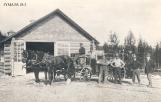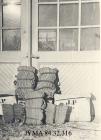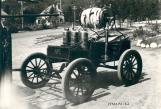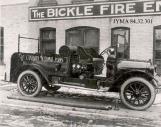14
Volunteers and Wardens testing fire extinguishing equipment.1922
Jasper National Park, Alberta, Canada

15
Government volunteers were usually not promised any sort of wage or compensation for aiding in the supression of a fire. However, sometimes the Chief Warden (on behalf of volunteers) would lobby the government for wages. The wage was usually miniscule; a volunteer may have received around $0.45 an hour for fighting a fire. Sometimes volunteers would receive payment for only a few hours of work.16
Jasper Fire Station (1914) with the Dominion Park Volunteer Fire brigade1914
Jasper fire station (1914), Geikie Street and Elm Avenue, Jasper National Park, Alberta, Canada

17
In 1914, Jasper's first fire station was built. The small, one storey, log structure was built by Dougald MacLachlan (1876-1942). The building cost the Dominion Government about $1,000 to build. The building and equipment belonged to the government and was primarily used to supress forest fires.The station housed a government employee who maintained the equipment and sounded and responded to calls of fire. The main alarm was a steam whistle located at the railroad Roundhouse. If the attendent was married his wife would usually aid in managing the fire records. Some of the early equipment included a borrowed water tank and later a horse drawn Brandon Chemical Wagon. The chemical wagon used cannisters filled with an acid and soda combination to help extinguish fires.
18
Early members of the Dominion Volunteer Fire Brigade.1920
Jasper fire station (1914), Geikie Street and Elm Avenue, Jasper National Park, Alberta, Canada

19
Dirty chimneys, locomotive engines, campers, and hoboes were some of the common causes for most fires in Jasper. Chimneys and locomotives were probably the most common cause for fires. Fires that were particularly devastating often became catalysts for improvements and new regulations for fire safety and prevention.The Bonner family fire in June of 1920 provides such an example. This tragic house fire was considered to be Jasper's most disasterous fire at that time. James Bonner and his young family had just completed their family dwelling and were awaiting the arrival of some new furnishings.
20
Bonner family headstone in Jasper Cemetery, Jasper National Park, Alberta, Canada.29 July 2003
Jasper Cemetery, Jasper National Park, Alberta, Canada

21
An article written in the Edmonton Journal (July 2, 1920), reported on the incident:"He [James Bonner] had been working all night at his occupation of car [for Grand Trunk] and knew nothing of the fire until the shrieking whistles in town called him from his work. Following along with the crowd to the scene of the fire; Mr. Bonner found his home in ruins with three children burned to death and the mother and baby on the point of death."
An inquest into the fire concluded it was accidental. Bonner had lost almost his entire family, except for his eldest son (age 8) who survived. The town of Jasper was devastated.
The Edmonton Journal also made mention of the government's fire fighting services: "Great praise is given to the government fire services for their promptness and skilful handling of a very dangerous situation." It was because of the Bonner family fire that the town lots were increased to a size of one hundred feet square. And a bell was added to the roof of the fire station.
22
Fire hose used by Dominion Volunteer Fire Brigade.1922
Jasper fire station (1914), Geikie Street and Elm Avenue, Jasper National Park, Alberta, Canada

23
The Western Canada Fire Underwriters' Association's report for the year 1923 concluded that the fire station and equipment were "fair" in relation to the size of Jasper.The 1914 fire station was still in use despite that it lacked a tower for drying hoses and was built from wood instead of brick. The steam whistle located at the railroad Roundhouse was also noted as ineffective because it sounded too much like a locomotive whistle.
24
The Dominion Park Volunteer Fire Brigade's inventory recorded at the time of the 1923 W.C.F.U.A.'s report included a 1922, four cylinder, Reo truck that had been rebuilt by the R.S. Bickle Company and was equipped with 2,600 feet of 2.5 inch unlined hose. The engine's rubber tires could also be replaced with iron flanged wheels and driven on the railway track (in case of a distant forest fire).There was a Brandon Chemical with double 50 gallon carbonic acid gas (stored pressure type). 100 feet of chemical hose; four bottles of gas, which were carried on the wagon and four to six others that were kept on hand. The Brandon Chemical Wagon also carried a 16 foot extension ladder.
There were five 2.5 gallon chemical extinguishers that were kept at the fire station while others were distributed to certain buildings around the townsite. Other minor equipment included axes, shovels, and lanterns. There was also several small portable gasoline engine driven pumps. These are probably similar or the same as the pumps shown in the early photographs of the wardens and volunteers testing their equipment.
It was also mentioned that the government's equipment and the equipment used by the Jasper Park Lodge hotel's volunteer brigade was incompatible. This meant if the two needed to share equipment or combine forces it would be very difficult.
25
Dominion Park Volunteer Fire Brigade's fire hose wagon.1922
Jasper fire station (1914), Geikie Street and Elm Avenue, Jasper National Park, Alberta, Canada

26
This hose wagon was most likely made from a Ford model 'T' chassis. It contained unlined linen hose, rubber lined hose, soda and acid fire extinguishers, axes and pails. The wagon could be pulled by horse or by car.27
The Reo Bickle combination Fire Engine with rotary gear pump.1922
The R.S. Bickle Fire Engine Factory, Woodstock, Ontario
